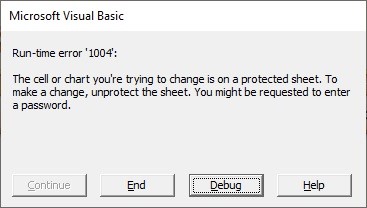

#Vba ontime code
The following code sorts the Items in the Inbox by Subject before looping through them.
#Vba ontime how to
The code at Retrieving E-mail shows how to loop through a folder without regard to the order of the items. If you want to loop though them in a specific order, you need to create an Items Collection variable and use the Sort method on that variable. When you loop through the Items in a Folder in Outlook, the items may not be in the order you want. For that reason, if you will potentially need to cancel an OnTime procedure, it’s best to store the EarliestTime in a variable that you can access to cancel it. To cancel a scheduled procedure, you have to know the exact time that it’s scheduled (its EarliestTime argument). The default is True (setting up a procedure to run) so it’s usually omitted in that instance. The Schedule argument determines whether you’re setting up a procedure to run or cancelling a previously scheduled procedure.

Other times, like hooking commandbarbutton events, you need the user to do whatever it is they’re going to do before your procedure runs. Why not just call it directly? Well, sometimes you have to trick Excel into doing what you want, like when you need to get around a bug. Now is the earliest it will run, so as soon as the current procedure is finished, it will run. That’s actually beneficial, because you can use OnTime to run directly after the current procedure, like this: MyProc will run no earlier than EarliestTime, but that’s no assurance that it will start then, such as when another macro is running. Notice how the argument isn’t called ExactTime. This line causes the procedure named MyProc to run in 5 minutes.Īpplication.OnTime Now + TimeSerial(0, 5, 0), "MyProc" Generally, the EarliestTime argument is set to a certain number of minutes or seconds from now. The syntax of this method, from help, isĪpplication.OnTime(EarliestTime, Procedure, LatestTime, Schedule) Counters will just count up to specified Timer set point and return True to the TD_ON shape's Prop.OUT which called the Add-In.The OnTime method can be used to schedule a procedure to run at a later time. In general, algorithm of "TD_ON" shape delays the time that the output is set to TRUE.ĭo you think that it is possible to do this with a special Add-In ? End user don't need to see the counting process, so there shouldn't be a user interface for counters in the add-in. You can start counters again by changing output of "DI" shape to False and True After 2 seconds related counter will disappear from the Excel since it finished its job.

Please find attached sample Visio and Excel files for you to see what they do.Ĭhange the output of "DI" shape to True while Excel file is open, connectors between "DI" shape and TD_ON shapes will turn to red which means that their value is True and this value will be propogated to TD_ON shapes's Prop.IN1 value and for each TD_ON shape a counter will start in Excel file counting up to a time which is defined in Prop.TimeDelay of TD_ON blocks.Īfter the specified TimeDelay set point passed, Excel will make the Prop.OUT of related TD_ON shape True and connector on the right side of the TD_ON shape will turn to red. Right now I use Application.OnTime method of Excel for real time calculations but an integrated solution in Visio would be better in terms of speed and reliability. I need your help to design a Visio add-in.


 0 kommentar(er)
0 kommentar(er)
